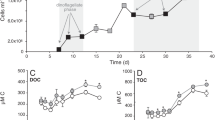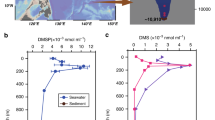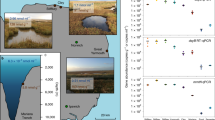Abstract
Marine phytoplankton produce ∼109 tonnes of dimethylsulfoniopropionate (DMSP) per year1,2, an estimated 10% of which is catabolized by bacteria through the DMSP cleavage pathway to the climatically active gas dimethyl sulfide3,4. SAR11 Alphaproteobacteria (order Pelagibacterales), the most abundant chemo-organotrophic bacteria in the oceans, have been shown to assimilate DMSP into biomass, thereby supplying this cell's unusual requirement for reduced sulfur5,6. Here, we report that Pelagibacter HTCC1062 produces the gas methanethiol, and that a second DMSP catabolic pathway, mediated by a cupin-like DMSP lyase, DddK, simultaneously shunts as much as 59% of DMSP uptake to dimethyl sulfide production. We propose a model in which the allocation of DMSP between these pathways is kinetically controlled to release increasing amounts of dimethyl sulfide as the supply of DMSP exceeds cellular sulfur demands for biosynthesis.
This is a preview of subscription content, access via your institution
Access options
Subscribe to this journal
Receive 12 digital issues and online access to articles
$119.00 per year
only $9.92 per issue
Buy this article
- Purchase on Springer Link
- Instant access to full article PDF
Prices may be subject to local taxes which are calculated during checkout



Similar content being viewed by others
References
Curson, A. R. J., Todd, J. D., Sullivan, M. J. & Johnston, A. W. B. Catabolism of dimethylsulphoniopropionate: microorganisms, enzymes and genes. Nature Rev. Microbiol. 9, 849–859 (2011).
Simó, R. Production of atmospheric sulfur by oceanic plankton: biogeochemical, ecological and evolutionary links. Trends Ecol. Evol. 16, 287–294 (2001).
Reisch, C. R., Moran, M. A. & Whitman, W. B. Bacterial catabolism of dimethylsulfoniopropionate (DMSP). Front. Microbiol. 2, 172 (2011).
Kiene, R. P., Linn, L. J. & Bruton, J. A. New and important roles for DMSP in marine microbial communities. J. Sea Res. 43, 209–224 (2000).
Malmstrom, R. R., Kiene, R. P., Cottrell, M. T. & Kirchman, D. L. Contribution of SAR11 bacteria to dissolved dimethylsulfoniopropionate and amino acid uptake in the North Atlantic ocean. Appl. Environ. Microbiol. 70, 4129–4135 (2004).
Vila-Costa, M., Pinhassi, J., Alonso, C., Pernthaler, J. & Simó, R. An annual cycle of dimethylsulfoniopropionate-sulfur and leucine assimilating bacterioplankton in the coastal NW Mediterranean. Environ. Microbiol. 9, 2451–2463 (2007).
Reisch, C. R. et al. Novel pathway for assimilation of dimethylsulphoniopropionate widespread in marine bacteria. Nature 473, 208–211 (2011).
Giovannoni, S. J., Cameron Thrash, J. & Temperton, B. Implications of streamlining theory for microbial ecology. ISME J. 8, 1553–1565 (2014).
Moran, M. A., Reisch, C. R., Kiene, R. P. & Whitman, W. B. Genomic insights into bacterial DMSP transformations. Annu. Rev. Marine Sci. 4, 523–542 (2012).
Tripp, H. J. et al. SAR11 marine bacteria require exogenous reduced sulphur for growth. Nature 452, 741–744 (2008).
Dunwell, J. M., Purvis, A. & Khuri, S. Cupins: the most functionally diverse protein superfamily? Phytochemistry 65, 7–17 (2004).
Curson, A. R. J., Rogers, R., Todd, J. D., Brearley, C. A. & Johnston, A. W. B. Molecular genetic analysis of a dimethylsulfoniopropionate lyase that liberates the climate-changing gas dimethylsulfide in several marine α-proteobacteria and Rhodobacter sphaeroides. Environ. Microbiol. 10, 757–767 (2008).
Todd, J. D. et al. DddQ, a novel, cupin-containing, dimethylsulfoniopropionate lyase in marine roseobacters and in uncultured marine bacteria. Environ. Microbiol. 13, 427–438 (2011).
Todd, J. D., Kirkwood, M., Newton-Payne, S. & Johnston, A. W. DddW, a third DMSP lyase in a model Roseobacter marine bacterium, Ruegeria pomeroyi DSS-3. ISME J. 6, 223–226 (2012).
Sun, J. et al. One carbon metabolism in SAR11 pelagic marine bacteria. PLoS ONE 6, e23973 (2011).
Carini, P., Steindler, L., Beszteri, S. & Giovannoni, S. J. Nutrient requirements for growth of the SAR11 isolate ‘Candidatus Pelagibacter ubique’ HTCC1062 on a defined medium. ISME J. 7, 592–602 (2013).
Kirkwood, M., Le Brun, N. E., Todd, J. D. & Johnston, A. W. B. The dddP gene of Roseovarius nubinhibens encodes a novel lyase that cleaves dimethylsulfoniopropionate into acrylate plus dimethyl sulfide. Microbiology 156, 1900–1906 (2010).
Todd, J. D., Curson, A. R. J., Sullivan, M. J., Kirkwood, M. & Johnston, A. W. B. The Ruegeria pomeroyi acuI gene has a role in DMSP catabolism and resembles yhdH of E. coli and other bacteria in conferring resistance to acrylate. PLoS ONE 7, e35947 (2012).
Brown, M. V. et al. Global biogeography of SAR11 marine bacteria. Mol. Syst. Biol. 8, 595 (2012).
Grote, J. et al. Streamlining and core genome conservation among highly divergent members of the SAR11 clade. mBio 3, 00252-12 (2012).
Kiene, R. P., Linn, L. J., González, J., Moran, M. A. & Bruton, J. A. Dimethylsulfoniopropionate and methanethiol are important precursors of methionine and protein-sulfur in marine bacterioplankton. Appl. Environ. Microbiol. 65, 4549–4558 (1999).
Sowell, S. M. et al. Transport functions dominate the SAR11 metaproteome at low-nutrient extremes in the Sargasso Sea. ISME J. 3, 93–105 (2009).
Reisch, C. R., Moran, M. A. & Whitman, W. B. Dimethylsulfoniopropionate-dependent demethylase (DmdA) from Pelagibacter ubique and Silicibacter pomeroyi. J. Bacteriol. 190, 8018–8024 (2008).
Tripp, H. J. et al. Unique glycine-activated riboswitch linked to glycine-serine auxotrophy in SAR11. Environ. Microbiol. 11, 230–238 (2009).
Gonzalez, J. M., Kiene, R. P. & Moran, M. A. Transformation of sulfur compounds by an abundant lineage of marine bacteria in the α-subclass of the class Proteobacteria. Appl. Environ. Microbiol. 65, 3810–3819 (1999).
Gonzalez, J. M. et al. Silicibacter pomeroyi sp. nov. and Roseovarius nubinhibens sp. nov., dimethylsulfoniopropionate-demethylating bacteria from marine environments. Int. J. System. Evol. Microbiol. 53, 1261–1269 (2003).
Burgmann, H. et al. Transcriptional response of Silicibacter pomeroyi DSS-3 to dimethylsulfoniopropionate (DMSP). Environ. Microbiol. 9, 2742–2755 (2007).
Varaljay, V. A. et al. Single-taxon field measurements of bacterial gene regulation controlling DMSP fate. ISME J. 9, 1677–1686 (2015).
Vallina, S. M. et al. A dynamic model of oceanic sulfur (DMOS) applied to the Sargasso Sea: simulating the dimethylsulfide (DMS) summer paradox. J. Geophys. Res. 113, G01009 (2008).
Polimene, L., Archer, S., Butenschön, M. & Allen, J. I. A mechanistic explanation of the Sargasso Sea DMS ‘summer paradox’. Biogeochemistry 110, 243–255 (2012).
Fang, Y. & Qian, M. C. Sensitive quantification of sulfur compounds in wine by headspace solid-phase microextraction technique. J. Chromatogr. A 1080, 177–185 (2005).
Vazquez-Landaverde, P. A., Torres, J. A. & Qian, M. C. Quantification of trace volatile sulfur compounds in milk by solid-phase microextraction and gas chromatography-pulsed flame photometric detection. J. Dairy Sci. 89, 2919–2927 (2006).
Stingl, U., Tripp, H. J. & Giovannoni, S. J. Improvements of high-throughput culturing yielded novel SAR11 strains and other abundant marine bacteria from the Oregon coast and the Bermuda Atlantic Time Series study site. ISME J. 1, 361–371 (2008).
Lindinger, W., Hansel, A. & Jordan, A. On-line monitoring of volatile organic compounds at pptv levels by means of proton-transfer-reaction mass spectrometry (PTR-MS): medical applications, food control and environmental research. Int. J. Mass Spectrom. Ion Proc. 173, 191–241 (1998).
Zhao, J. & Zhang, R. Proton transfer reaction rate constants between hydronium ion (H3O+) and volatile organic compounds. Atmos. Environ. 38, 2177–2185 (2004).
Acknowledgements
The authors thank J.W.H. Dacey for providing DMSP and E. Boss for help with modelling the transport kinetics. The authors thank J.W.H. Dacey and S. Bennett for advice regarding the methods for DMSP measurements and N. Le Brun for suggestions on the properties of the cupin lyases and kinetics analysis. J.S. acknowledges China Scholarships Council (CSC) for financial support. Major support was provided by a grant from the Marine Microbiology Initiative of the Gordon and Betty Moore Foundation (grant no. GBMF607.01 to S.J.G.). Proteomics measurements were supported by the US Department of Energy's (DOE) Office of Biological and Environmental Research (OBER) Pan-omics programme at Pacific Northwest National Laboratory (PNNL) and performed in the Environmental Molecular Sciences Laboratory, a DOE OBER national scientific user facility on the PNNL campus. A.W.B.J. and J.D.T. were supported by grant no. NE/H008586/1 from the UK Natural Environment Research Council and E.K.F. was supported by a studentship from the Tyndall Centre at the University of East Anglia. Funds for the PTR-TOF were provided by NASA (grant no. NNX15AE70G to K.H.H. and S.J.G.) and by a grant to K.H.H. from the Oregon State University Research Office. This research was supported by the US National Science Foundation (grant OCE-1436865).
Author information
Authors and Affiliations
Contributions
J.S. and S.J.G. conceived and designed the experiments. J.S., Y.Q. and M.C.Q. measured DMSP products and intracellular DMSP concentration. J.S. and J.G. performed the physiological growth experiments for HTCC1062. J.S. and J.C.T. analysed and proposed DMSP metabolic pathways. J.D.T., E.K.F. and A.W.B.J. designed and implemented the cloning, expression and characterization of DddK. B.T. performed metagenomics analyses. B.T., J.T.A., C.D.N., M.S.L., R.D.S. and S.H.P. performed iTRAQ and data analyses. P.D.L. and S.J.G. proposed the model. C.L.D.-M. and K.H.H. measured real-time DMS/MeSH production by PTR-TOF/MS. S.J.G. contributed reagents, materials and analysis tools.
Corresponding author
Ethics declarations
Competing interests
The authors declare no competing financial interests.
Supplementary information
Supplementary information
Supplementary Notes I-V, Supplementary Figures 1-9, Supplementary Tables 1-3, Supplementary Table 4 Legend, Supplementary Methods and Supplementary References (PDF 1476 kb)
Supplementary Table 4
(XLS 67 kb)
Rights and permissions
About this article
Cite this article
Sun, J., Todd, J., Thrash, J. et al. The abundant marine bacterium Pelagibacter simultaneously catabolizes dimethylsulfoniopropionate to the gases dimethyl sulfide and methanethiol. Nat Microbiol 1, 16065 (2016). https://doi.org/10.1038/nmicrobiol.2016.65
Received:
Accepted:
Published:
DOI: https://doi.org/10.1038/nmicrobiol.2016.65
This article is cited by
-
Ubiquitous occurrence of a dimethylsulfoniopropionate ABC transporter in abundant marine bacteria
The ISME Journal (2023)
-
The biogeochemistry of marine dimethylsulfide
Nature Reviews Earth & Environment (2023)
-
Ecophysiology and genomics of the brackish water adapted SAR11 subclade IIIa
The ISME Journal (2023)
-
DMSOP-cleaving enzymes are diverse and widely distributed in marine microorganisms
Nature Microbiology (2023)
-
Influence of short and long term processes on SAR11 communities in open ocean and coastal systems
ISME Communications (2022)



